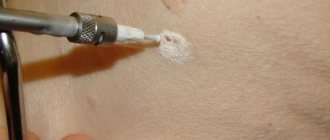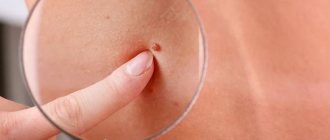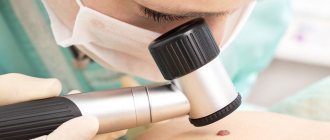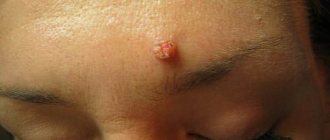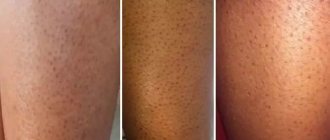Let's start with what warts are in general. Warts, or papillomas, are dense, nodular, round or flat growths that most often form in 5 areas of the body:
- Palms
- Feet
- Armpits
- Genitals
- Face
You've probably heard many myths about warts. For example, that they arise from contact of the skin of the hands with frogs and toads, or that it is simply a superficial skin disease. In fact, papillomas of any type in children and adults have only one cause - the human papillomavirus (HPV). Warts are only an external manifestation of this disease.
HPV and warts
HPV is a whole group of viruses that infect humans. Several dozen strains of HPV can live in the body of one person, but this does not pose any threat to health if you have a strong immune system and do not have serious chronic diseases that weaken it. HPV does not manifest itself in any way until the body’s immune functions decrease to a certain level. If you notice warts on yourself, you should think first not about the aesthetic appearance of your skin, but about your health.
It is worth understanding that HPV is not some rare disease. It occurs in at least half of the world's population, it simply does not manifest itself, and is dangerous only in a number of cases.
Infection with the human papillomavirus occurs during sexual intercourse or kissing, when sharing personal hygiene items - towels, washcloths, nail scissors, etc.
Causes
The onset of the disease is preceded by the introduction of viral particles into the skin (we are talking about papillomavirus).
When immunity decreases, HPV actively multiplies, causing characteristic growths to appear on the skin. Infection can occur in the following ways:
- when shaking hands with an infected person;
- through holders in public transport;
- when using towels from a sick household member;
- through contaminated manicure instruments.
The risks increase with hyperhidrosis of the hands and damaged skin (infection occurs especially often in winter, when the skin dries and cracks due to the cold).
Types of warts and their location
1. Simple or vulgar warts occur mainly in children and adolescents. These are round, dense growths on the hands, face or lips. More than 65% of all skin warts are of this type. 2. Flat warts of various shapes with a smooth surface appear in adolescence on the fingers, feet, and oral mucosa and are not common - only 3-4% of all cases. 3. Palmoplantar papillomas can appear at any age. These are hard, round formations with layers of keratinized layers of skin. Most often they form on the feet and over time cause a person severe pain when walking. 4. Thread-like papillomas of flesh-colored, brown or coffee color are located in the folds of the skin of different parts of the body - genitals, armpits, eyelids, neck. These are elongated warts with a “pedicle”. 5. Soft genital warts are located on the mucous membranes in the groin, rectum or urethra. They manifest themselves in the form of a ball, pyramid or nodular cluster, and are rarely found in a single copy. Genital warts are often multiple growths with a keratinized surface.
Removing an itchy wart
Warts on any part of the body can be removed.
They may appear on the back, legs, arms or face.
In the genital area, warts that itch can also be removed.
The procedure has two goals:
- aesthetic – a person with warts looks ugly, but after their removal his appearance improves
- medical - distant formations are not capable of degenerating into cancer
There are many ways to remove warts that itch.
The oldest of them is cryodestruction.
Warts are simply frozen with liquid nitrogen.
After this they are rejected.
But this method is not always effective.
It removes the formations themselves, but does not destroy viruses.
Therefore, cryodestruction is undesirable when there is a high oncogenic risk.
Liquid nitrogen does not remove warts that are too large.
Because they cannot always be completely frozen.
And with increasing application time, the risk of scar formation increases.
This is possible when cold damages the deep layers of the skin.
Cryodestruction has one more drawback.
If there is a suspicious wart that itches and enlarges, it cannot be sent for histological examination.
Because during removal it is destroyed.
The wart is destroyed rather than separated from the body.
Accordingly, there is simply nothing to send for histology.
In our clinic, for large warts, other methods of removing them are used.
We use laser, electrocoagulation, and radio wave removal.
We consider the latter method to be the optimal choice.
Because with radio wave removal of warts:
- no damage to deep layers of skin
- the wart is separated from the body, and tissue is preserved that can be sent for histological examination
- minimal risk of scarring
The procedure is performed under local anesthesia.
During removal of the formation, the patient does not feel pain.
How to treat warts
Answering the question in the title of the article, we will say: you need to remove warts, but only as prescribed by a doctor. In no case on your own! In some cases, removal is contraindicated, so be examined before making a decision.
In modern medicine, warts are safely removed using surgery, electric current, laser or liquid nitrogen. Such procedures do not leave serious scars on the skin and help quickly get rid of papillomas. At the same time, the patient is prescribed specially selected antiviral and immunomodulatory therapy, which helps suppress the HPV outbreak and significantly increase immunity.
If the wart is small in size, does not grow and does not interfere with the natural movement of the body, then you can try to cure it with special ointments. Treatment takes a lot of time and is always discussed between the doctor and the patient during the examination.
Also, every patient should understand that today there are no medications or procedures that can permanently rid the body of HPV. No one is immune from relapses. But you can suppress the influence of HPV with the help of a healthy lifestyle, increasing the body’s immune functions, hygiene and barrier contraception.
Papilloma on the eyelid
Symptoms: what papillomas look like on the eyelids
Externally, papillomas on the eyelids look like a small growth, the color of which does not differ from the color of healthy skin. The size of the neoplasm rarely exceeds 1-2 millimeters, although there are cases where the growth has reached a centimeter in diameter. The surface of the skin over the affected area is rough. The formation is painless, but if it is mechanically damaged, unpleasant sensations are possible.
The specificity of papillomas on the eyelids is that they can cause significant physical discomfort and even medical problems. Patients often complain of a feeling of “sand” or a foreign body in the eye, although the formation is located on the outer surface of the eyelid. Possible symptoms include watery eyes or dry eyes. Some patients develop conjunctivitis and blepharitis. Although these conditions do not pose a serious threat to health or vision, if papilloma appears on the eye, it is better to seek the help of a specialist as soon as possible.
How to get rid of papillomas?
Since papilloma is not just a skin growth and an aesthetic defect, but a manifestation of a chronic viral infection, solving the problem requires an integrated approach using various areas of treatment.
The patient is prescribed non-specific antiviral therapy with drugs that suppress the reproduction and activity of the virus. For these purposes, the doctor may prescribe Panavir, Acyclovir, oxolinic ointment and other antiviral agents.
The second direction of treatment is to increase the general and local resistance of the body to pathogens of infectious diseases. To strengthen the immune system, immunostimulants are prescribed. Echinacea has a general strengthening effect on the body. You can use medicinal herbs. Drugs that promote the production of interferon (Viferon) have a more specific effect.
Removal of papilloma on the eyelid is the most important condition for successful therapy. Why is it important to get rid of education? The growth is a focus of infection, and the virus is in active form. On the one hand, formations on the eyelid represent a cosmetic defect. On the other hand, it can lead to infection of family members. Finally, removing the source of infection contributes to the complete elimination of the pathogen from the host’s body.
Removal methods
How to remove papilloma on the eyelid? Because the skin on the eyelid is very thin, with the advent of modern surgical technologies, traditional surgical removal of papilloma is rarely used. In Moscow clinics, these formations are removed using microsurgical equipment - a laser, electrocoagulation or radio wave scalpel.
Laser papilloma removal is considered the most effective and safe. The procedure, which is performed using a carbon dioxide laser, has the following advantages:
- With the help of local anesthetics, removal can be done painlessly.
- The laser has stimulating properties and promotes rapid healing of the skin after surgery.
- Thanks to the coagulating properties of the laser, bleeding and damage to healthy skin areas are minimized.
- There is no risk of infection, since the laser cannot be a source of infection and has a detrimental effect on viral and bacterial flora. Thanks to these properties, the laser increases the effectiveness of antiviral therapy and helps eliminate infection.
- The rehabilitation period is short.
- There is no risk of scar or scar formation.
- There is no risk of relapse of the disease.
Removing the growth at home is a less effective (most often ineffective) tactic. Local use of traditional medicine is not justified; you should contact a specialist immediately when a formation appears.
Why are traditional methods of treatment dangerous?
Many people remember cauterization with celandine, iodine and vinegar from childhood. Some people removed warts using a silk thread, while others applied hot metal objects to them to burn them out! All these methods are not only ineffective in the fight against warts and HPV, but also dangerous to human health.
As a result of such “home” treatment, a child or adult can receive multiple burns, scars and welts, and removal with a thread only provokes further growth and spread of papillomas on the skin.
We live in the 21st century, where there are modern methods of treatment and correction that are safe for health. If you find papillomas on the skin or mucous membranes, first make an appointment with a dermatovenerologist or gynecologist. The doctor will prescribe treatment and, if necessary, refer you to a surgeon for quick removal of the papilloma.
The MC “Health” network welcomes doctors - gynecologists, dermatovenereologists and surgeons with extensive experience. Hundreds of patients come to appointments with external manifestations of HPV, and our specialists consider each case individually - prescribe the necessary tests and studies, adjust treatment, and help quickly cope with the disease. You can make an appointment with any doctor on the clinic’s website.
Don’t delay the examination and get treatment from professionals!
What to do if a wart itches
If the wart itches, turns red, ulcerates, or quickly increases in size, you should see a doctor.
Because complications are possible.
The most dangerous of them is malignancy of the skin formation.
That is, it can turn into cancer.
The risk of degeneration can be assessed in advance, even before the appearance of pathological symptoms.
To do this, scrape the skin.
The resulting material is examined by PCR for oncogenic types of papilloma viruses.
All viruses can have an oncogenic risk:
- short
- average
- high
Highly oncogenic types are not so common.
But they are the ones that cause the most cases of squamous cell carcinoma.
If during the study no oncogenic types of the virus were detected, this indicates that malignant degeneration of the wart is unlikely.
If they are identified, then the risk is high.
In this case, patient monitoring is required.
He himself must carefully monitor his warts.
If signs of degeneration appear, you should consult a doctor to undergo examination and receive treatment.
It is even better to remove all formations so that they definitely do not degenerate into cancer.
After removal, the wart is sent for histological examination.
It allows you to evaluate the structure of the tissue and find out whether there are signs of a malignant tumor.
Clinical picture
Warts on the hands do not differ much in color from the surrounding tissues, rarely taking on a reddish tint. Hair may grow from it (this is normal and should not be alarmed). The surface of the neoplasm is relatively flat and smooth, but then it becomes harder due to progressive keratinization. The skin pattern disappears, and over time, individual warts merge, occupying an increasingly larger area. Brushes are an aesthetically significant area, so sooner or later you have to decide on removing the defect.
